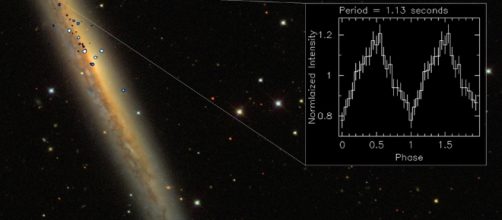With the aid of the Nuclear Spectroscopic Telescope Array (NuSTAR), astronomers were able to discover the brightest pulsar (NGC 5907 ULX) ever found. The pulsar is situated 50 million light years away from earth, making it the farthest Neutron Star to date. Its luminosity is 1,000 times greater than the maximum detected for this types of neutron stars. The rare luminosity is not really understood and this phenomenon is raising new ideas on the way in which pulsar accrue matter.
Pulsars
This is a neutron star that spins with regular time periods emitting beams of electromagnetic radiation.
When this beams of light intersect with the earth, they are detected as pulses of light. This stars are very dense and possess very precise rotational periods, ranging from the milliseconds to seconds. They are believed to cause charged particles to high and ultra-high energies. Pulsars were used to confirm the existence of gravitational radiation and the first exoplanets were discovered in their vicinity. These types of stars are the remnants of supernovae explosions.
Previous discovered bright pulsars
M82 X-2 situated 12 million light years from the earth in the Cigar Galaxy-discovered in 2012, was the previous, most recent discovered luminous neutron star-10 times less luminous than NGC 5907 ULX.
NGC 7793 P13 is the third most luminous known. It had been thought that these bright dense bodies were black holes, before their discovery. Now, scientists call them ultra-luminous X-ray sources, as they are brighter than could be expected from a black hole with the size of 10 solar masses.
Ultra luminous X-ray sources
The processes that make this objects shine so brightly is a mystery; however, astronomers think that pulsars possess very strong magnetic fields at their surfaces, forcing the incoming material to flow through their field lines. The rotating filed lines then drive the charged particles to ultra-high energies. It´s believed that most ultra-luminous X-ray sources are not black holes, but pulsars. The recent discovery will have astronomers reconsidering the way in which pulsars absorb matter.

